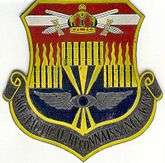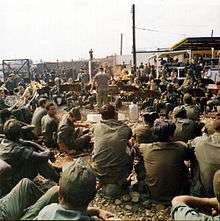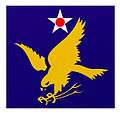460th Space Wing
| 460th Space Wing | |
|---|---|
| Active | 19 August 2004 |
| Country |
|
| Branch |
|
| Type | Space |
| Role | Early warning and space defense |
| Size | 1,800 personnel |
| Part of | Air Force Space Command |
| Garrison/HQ | Buckley Air Force Base |
| Motto(s) | Persistent Global Surveillance |
| Mascot(s) | Panther |
| Equipment | Ground radar and satellite telecom |
| Decorations |
Distinguished Unit Citation Presidential Unit Citation Air Force Outstanding Unit Award with Combat "V" Republic of Vietnam Gallantry Cross with Palm |
| Commanders | |
| Current commander | Colonel John Wagner |
| Insignia | |
| 460th Space Wing emblem (approved 3 December 2001)[1] |
 |
| 460th Tactical Reconnaissance Wing emblem (approved 30 August 1966)[2] |
 |
The 460th Space Wing is located at Buckley Air Force Base, east of Aurora, Colorado.[3] The 460th delivers global infrared surveillance, provides worldwide missile warning and tracking for homeland defense purposes, and deploys personnel to combatant commanders worldwide.[4]
Organization
The 460th Space Wing is directed by Air Force Space Command.[3] The wing is divided into three groups: the 460th Operations Group, the 460th Mission Support Group, and the 460th Medical Group.
The 460th Operations Group provides missile warning, missile defense, technical intelligence, satellite command and control, and robust aerospace communications. The group operates the Defense Support Program and Space-Based Infrared System (SBIRS) satellites, providing persistent global surveillance, tracking, and targeting.[3]
The 460th Mission Support Group provides trained personnel to support the Air Expeditionary Forces and Homeland Defense. Specific capabilities include force protection, human resources management, contracting, and logistics. Since the 460th is the host unit at Buckley AFB, the 460th MSG also maintains the base's infrastructure and environmental controls.[3]
The 460th Medical Group supports military readiness to the Air Expeditionary Forces and Homeland Defense missions by ensuring base personnel are medically qualified for deployments. The medical group also provides quick-response services to the Air Expeditionary Forces and the Department of Homeland Security, as well as more traditional health-care services such as optometry, wellness services and dental care.[3]
Space Operations
The 460th Space Wing provides national leadership, Unified Combatant Command commanders, troops in theater and intelligence communities information to formulate and adjust defense strategies, deter against growing global threats, and react to impending attacks. Space operators use a network of satellite ground stations around the world to communicate with the SBIRS and DSP spacecraft.
Space-Based Infrared System
SBIRS is to consist of six dedicated satellites operating in geosynchronous earth orbit (GEO), and sensors on two host satellites operating in a highly elliptical orbit (HEO). SBIRS will replace the Defense Support Program satellites and is intended primarily to provide enhanced strategic and theater ballistic missile warning capabilities.
Defense Support Program
The DSP satellites are in geosynchronous orbits, and are equipped with infrared sensors operating through a wide-angle Schmidt camera. The entire satellite spins so that the linear sensor array in the focal plane scans over the earth in a radial pattern. The last DSP satellite was launched in 2007 aboard the first operational flight of the Delta IV Heavy rocket.
History
World War II


Constituted as 460th Bombardment Group (Heavy) in May 1943. Activated on 1 July 1943. Activated as a B-24 Liberator heavy bombardment unit; assigned to II Bomber Command for training. Primarily trained in New Mexico and Utah. Received deployment orders for the Mediterranean Theater of Operations (MTO) in August 1943. Moved to Georgia and Virginia where the group flew coastal patrol missions over the Southeast, October 1943 – January 1944 while station in Italy was being constructed.
Deployed to Southern Italy in January 1944; entered combat in January 1944, being assigned to Fifteenth Air Force 55th Bombardment Wing. Engaged in very long range strategic bombing missions to enemy military, industrial and transportation targets in Italy, France, Germany, Austria, Hungary, Romania, and Yugoslavia, bombing railroad marshalling yards, oil refineries, airdrome installations, heavy industry, and other strategic objectives.
The group flew its last World War II combat mission on 26 April 1945. After V-E Day, was assigned to Green Project which was the movement of troops from Europe to the United States via the South Atlantic Transport Route. B-24s were modified with sealed bomb bays, removal of all defensive armament and internal fuselage equipped with seating to carry approximately 30 personnel. Was assigned to Air Transport Command at Waller Field, Trinidad and to Natal, Brazil. Moved personnel from Dakar in French West Africa where personnel were transported across the South Atlantic to Brazil and eventually to Morrison Field, Florida via Trinadad. Provided air transport until the end of September when the unit was inactivated.
Vietnam War
- See also: Tan Son Nhut Air Base

On 2 February 1966, the 460th Tactical Reconnaissance Wing was activated and entered the Vietnam War. Its headquarters shared the Seventh Air Force Headquarters and the Military Assistance Command Vietnam (MACV).
When it stood up, the 460th TRW, alone, was responsible for the entire reconnaissance mission, both visual and electronic reconnaissance, throughout the Southeast Asia (SEA) area of responsibility. On 18 February 1966 the 460th TRW began with 74 aircraft of various types. By the end of June 1966, that number climbed to over 200 aircraft. On 15 October 1966, the 460th TRW assumed host wing responsibilities for Tan Son Nhut Air Base, to include being responsible for all depot-level aircraft maintenance responsibility for all USAF organizations in South Vietnam.
During the end of 1966, the 460th TRW and its responsibilities changed. First, on 18 September 1966, the 432d Tactical Reconnaissance Wing was activated at Takhli Royal Thai Air Force Base, Thailand. After the 432d TRW activated it took control of the reconnaissance squadrons in Thailand. With the activation of the 432d TRW, the 460th TRW was no longer responsible for all air reconnaissance missions throughout the SEA area of responsibility. However, the 460th TRW provided the new 432d TRW with continued support in recovering RF-101 and RF-4C aircraft returning from high priority, high interest target missions.
Being one of two reconnaissance wings supporting SEA there were few military operations that did not involve the 460th TRW. Not only did the 460th TRW provide electronic and photo reconnaissance, the Wing’s electronic capabilities allowed it to provide electronic counter measure support to B-52s returning from striking targets in North Vietnam. The Wing even gave support to the Cambodian military against the North Vietnam and Viet Cong forces, as well as support to US units operating inside Cambodia.
As the Vietnamization Improvement and Moderization Program began, Vietnamese crews began flying with EC-47 crews from the 360th TEWS and 6994th SS, on 8 May 1971, to get training on operating the aircraft and its systems. The wing was inactivated in-place on 31 August 1971.
Taegu Air Base

On 19 September 1989, the 460th Tactical Reconnaissance Wing redesignated to become the 460th Tactical Reconnaissance Group (TRG). The following month, 1 October 1989, the renamed Group reactivated at Taegu Air Base, South Korea. Behind this activation was Pacific Air Forces’s (PACAF) portion of Phase II of an Air Staff programming plan, Commando Flash.
Activating the 460th TRG and relocating the 15th Tactical Reconnaissance Squadron with its RF-4C Phantom IIs from Kadena Air Base, Japan to Taegu AB under the 460th TRG accomplished several PACAF objectives. This activation maintained Taegu AB as a main operating base, allowed the RF-4C crews to train in their actual wartime operating area, placed reconnaissance aircraft near North Korea, and reduced the TDY costs for PACAF. Upon its activation, the 460th TRG reported directly to 7th Air Force. During its time at Taegu AB, the Group participated in several local and PACAF exercises designed to maintain the readiness of US forces stationed around the Korean demilitarized zone and other units designated as support units should North Korea invade South Korea again.
A year later, 1 October 1990, the 460th TRG was inactivated along with the 15th TRS. Some of the Group’s subordinate units remained active after the Group’s inactivation. The 460th Consolidated Aircraft Maintenance Squadron remained active until 15 October 1990. On 1 July 1991, the 460th Combat Support Squadron finally inactivated.
Post Cold War era
On 1 October 2001, the 460th Air Base Wing was reactivated to assume full control of Buckley AFB in Aurora, Colorado. On 1 October 2000, the United States Air Force took control of the former Naval Air Station Denver and it was assigned the 821st Space Group to oversee its operations.[6]
A year later, control of Buckley AFB was transferred to the newly reactivated 460th Air Base Wing. Under the 460th's command, the base underwent an extensive modernization program to improve the base's support facilities. The 460th oversaw construction of one of the largest DeCA base commissary and AAFES base exchange complexes in the Air Force, as well as a fitness center, dorms, and other housing areas for Buckley Airmen.[6]
On 19 August 2004, the wing was redesignated as the 460th Space Wing. The 460th SW, while retaining control of Buckley AFB, assumed command for several squadrons from the 21st Space Wing, which was also located at Buckley. Today, the 460th delivers global infrared surveillance, tracking and missile warning for theater and homeland defense and provides combat commanders with expeditionary warrior Airmen.[3]
Lineage
460th Bombardment Group
- Established as 460th Bombardment Group (Heavy) on 19 May 1943
- Activated on 1 July 1943
- Redesignated 460th Bombardment Group, Heavy c. 3 September 1944
- Inactivated on 26 September 1945
- Consolidated with the 460th Tactical Reconnaissance Wing as the 460th Tactical Reconnaissance Wing on 31 January 1984[1]
460th Space Wing
- Established as the 460th Tactical Reconnaissance Wing and activated on 2 February 1966 (not organized)
- Organized on 18 February 1966
- Inactivated on 31 August 1971
- Consolidated with the 460th Bombardment Group on 31 January 1984
- Redesignated 460th Tactical Reconnaissance Group on 19 September 1989
- Activated on 1 October 1989
- Inactivated on 1 October 1990
- Redesignated 460th Air Base Wing on 26 April 2001
- Activated on 1 October 2001
- Redesignated 460th Space Wing on 19 August 2004[1]
Assignments
- II Bomber Command, 1 July 1943
- Second Air Force, 6 October 1943
- I Bomber Command, c. 29 October 1943
- 55th Bombardment Wing, c. 5 February 1944
- South Atlantic Division, Air Transport Command, 15 June-26 September 1945
- Pacific Air Forces, 2 February 1966 (not organized)
- 2d Air Division, 18 February 1966
- Seventh Air Force, 1 April 1966 – 31 August 1971; 1 October 1989 – 1 October 1990
- Fourteenth Air Force, 1 October 2001 – present[1]
Components
Groups
- 460th Operations Group: 19 August 2004 – present[1]
Squadrons
- 12th Tactical Reconnaissance Squadron: 2 September 1966 – 31 August 1971
- 15th Tactical Reconnaissance Squadron: 1 October 1989 – 1 October 1990
- 16th Tactical Reconnaissance Squadron:18 February 1966 – 15 March 1970
- 20th Tactical Reconnaissance Squadron: 18 February - 18 September 1966
- 41st Tactical Reconnaissance Squadron: 18 February - 18 September 1966
- 45th Tactical Reconnaissance Squadron: attached 30 March – 7 July 1966
- 360th Reconnaissance (later, 360th Tactical Electronic Warfare) Squadron: 8 April 1966 – 31 August 1971
- 361st Reconnaissance (later, 361st Tactical Electronic Warfare) Squadron: 8 April 1966 – 31 August 1971
- 362d Reconnaissance (later, 362d Tactical Electronic Warfare) Squadron: 1 February 1967 – 31 August 1971
- 760th Bombardment Squadron: 1 July 1943 – 26 September 1945
- 761st Bombardment Squadron: 1 July 1943 – 26 September 1945
- 762d Bombardment Squadron: 1 July 1943 – 26 September 1945
- 763d Bombardment Squadron: 1 July 1943 – 26 September 1945
- 6460th Tactical Reconnaissance Squadron: 8 June - 18 September 1966
- 6461st Tactical Reconnaissance Squadron: 29 July - 18 September 1966.[1]
Stations
|
|
Aircraft
|
|
Unit Decorations
During its relatively short active-duty time, the 460th has been awarded numerous times for its effort. The 460th has received the Distinguished Unit Citation, four Presidential Unit Citations, five Air Force Outstanding Unit Awards (2 with Combat "V" device). These esteemed decorations came from direct service in twenty-two different campaigns during World War II, Vietnam, the Cold War, and during operations in the support of the Global War on Terror.
- The 460th Heavy Bombardment Group earned a Distinguished Unit Citation for leading the 55th Bomb Wing through adverse weather and heavy enemy fire to attack an airfield and aircraft facilities in Zwolfaxing, Austria, on 26 July 1944. The group also flew some interdiction and support missions and supported the invasion of southern France in August 1944 by raiding submarine pens, marshalling yards and gun positions in the assault area. It struck bridges, viaducts, ammunition dumps, railroads and other targets to aid the advance of Allied forces in northern Italy.
See also
- 137th Space Warning Squadron (140th Wing)
- 516th Air Service Group World War II support organization for 460th Bombardment Group
References
Notes
- 1 2 3 4 5 6 7 8 Robertson, Patsy (December 28, 2007). "Factsheet 460 Space Wing (AFSPC)". Air Force Historical Research Agency. Retrieved November 22, 2016.
- ↑ Ravenstein, pp. 253-254
- 1 2 3 4 5 6 "Buckley AFB 460th Space Wing Fact Sheet". Archived from the original on 29 June 2007. Retrieved 8 October 2008.
- ↑ "Welcome to Buckley Air Force Base". Retrieved 8 October 2008.
- ↑ Martin Rosenkranz. "The 15th US Army Air Force in July 1944". Retrieved 7 October 2008.
- 1 2 "History of Buckley Air Force Base". Archived from the original on 12 February 2008. Retrieved 13 October 2008.
Bibliography
![]() This article incorporates public domain material from the Air Force Historical Research Agency website http://www.afhra.af.mil/.
This article incorporates public domain material from the Air Force Historical Research Agency website http://www.afhra.af.mil/.
- Maurer, Maurer, ed. (1983) [1961]. Air Force Combat Units of World War II (PDF) (reprint ed.). Washington, DC: Office of Air Force History. ISBN 0-912799-02-1. LCCN 61060979.
- Ravenstein, Charles A. Air Force Combat Wings, Lineage & Honors Histories 1947-1977 (PDF). Washington, DC: Office of Air Force History. ISBN 0-912799-12-9.


.svg.png)

.jpg)
